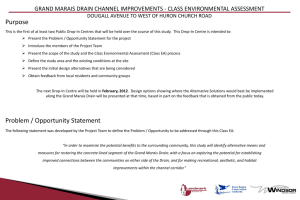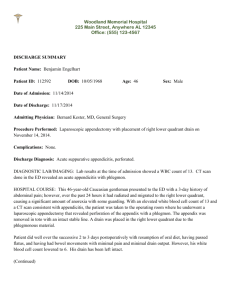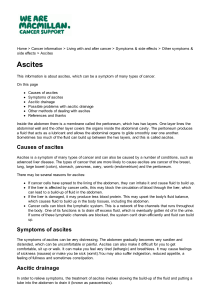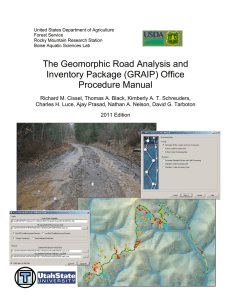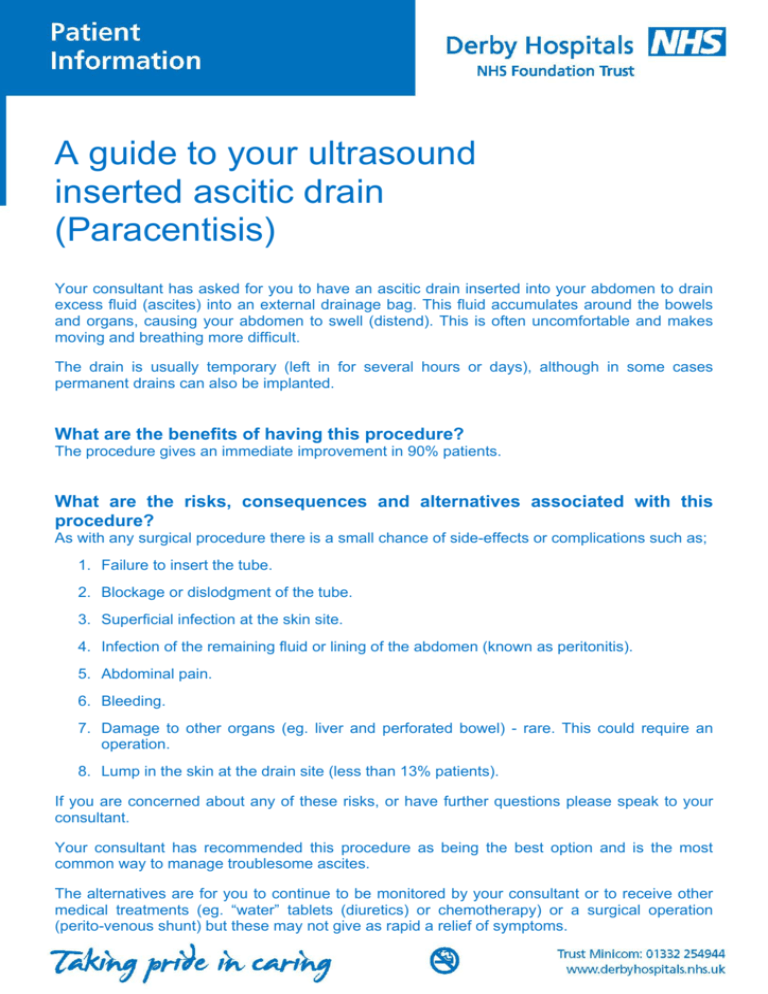
A guide to your ultrasound
inserted ascitic drain
(Paracentisis)
Your consultant has asked for you to have an ascitic drain inserted into your abdomen to drain
excess fluid (ascites) into an external drainage bag. This fluid accumulates around the bowels
and organs, causing your abdomen to swell (distend). This is often uncomfortable and makes
moving and breathing more difficult.
The drain is usually temporary (left in for several hours or days), although in some cases
permanent drains can also be implanted.
What are the benefits of having this procedure?
The procedure gives an immediate improvement in 90% patients.
What are the risks, consequences and alternatives associated with this
procedure?
As with any surgical procedure there is a small chance of side-effects or complications such as;
1. Failure to insert the tube.
2. Blockage or dislodgment of the tube.
3. Superficial infection at the skin site.
4. Infection of the remaining fluid or lining of the abdomen (known as peritonitis).
5. Abdominal pain.
6. Bleeding.
7. Damage to other organs (eg. liver and perforated bowel) - rare. This could require an
operation.
8. Lump in the skin at the drain site (less than 13% patients).
If you are concerned about any of these risks, or have further questions please speak to your
consultant.
Your consultant has recommended this procedure as being the best option and is the most
common way to manage troublesome ascites.
The alternatives are for you to continue to be monitored by your consultant or to receive other
medical treatments (eg. “water” tablets (diuretics) or chemotherapy) or a surgical operation
(perito-venous shunt) but these may not give as rapid a relief of symptoms.
Getting ready for the procedure
If you are not already in hospital, you will be asked to report to the ward on the day of the
procedure. Your appointment letter will give details of this.
A nurse will discuss the procedure with you. You may need to undergo some routine tests
before the procedure eg. blood test.
You will be asked not to eat for at least 4 hours before the procedure, although you can drink.
You will be advised of the actual time.
You should continue most medications but must inform us if you are taking warfarin or
clopidogrel (Plavix) or any other medication to thin the blood.
You will be asked some routine questions about your general health, the medicines you take at
the moment and any allergies you may have.
You will be asked to sign a consent form to say that you understand what you have come into
hospital for and what the procedure involves.
If the skin around the area where the drain is to be inserted is particularly hairy, the nursing staff
may clip it using specialised clippers (so as to not cut or damage the area before the
procedure). Please do not shave the area yourself.
A small tube (cannula) may be inserted into an arm vein.
You will be given a theatre gown to wear. A nurse or porter will take you on a trolley to the
ultrasound department.
What sort of anaesthetic will I have?
Your procedure will be carried out using local anaesthetic to numb the skin. You may also be
offered Entonox gas to help you relax. This will be discussed with you.
What happens during my ascitic drain insertion?
You will be brought to the ultrasound department on a trolley.
The procedure usually takes 20 - 30 minutes. A nurse will be with you at all times.
You will be lying flat or as near to flat as you can comfortably manage during the procedure.
You will be awake throughout the procedure.
The skin over your abdomen will be cleaned and numbed with local anaesthetic.
The abdominal wall will be punctured with a fine needle and a small hole created through which
the thin tube can be passed. This is then secured by a large dressing to the surface of the skin
and a drainage bag is connected to collect the fluid. Fluid will be drained off slowly over hours or
days but gives an immediate improvement in 90% patients.
You will then be taken back to the ward and closely observed for a few hours.
What should I expect after the procedure?
You will be taken back to the ward on a trolley.
A nurse will check your breathing, pulse and blood pressure for several hours.
If you experience pain it is important to tell the nurses who can give you painkillers to help.
The nursing staff will monitor the amount and rate in which the fluid drains.
You will be able to move around with the drain in place. Please check with the nursing staff first
as you may need a leg bag or similar to carry the drainage bag in.
You can shower but only with a waterproof dressing in place. Please check with the nursing
staff before showering.
Going home
You will need to stay in hospital until the drain has been removed. This is usually done on the
ward after a day or two.
DISCHARGE INFORMATION AND AT HOME ADVICE
The drain will be removed before you go home. You will have a dressing over the wound.
Pain relief
It is usual to feel some pain following this procedure, take either the painkillers you were given
from the hospital or a mild painkiller such as paracetamol - follow the manufacturer’s
instructions and do not exceed the recommended dose.
Returning to normal activities
You should avoid strenuous exercise, lifting and driving for a couple of days.
References
“Abdominal paracentesis” The Royal Marsden Hospital Manual of Clinical Nursing Procedures 6th Ed
Online: www.herhis.nhs.uk/RMCNP/content/mars03.htm
“Controlling malignant ascites” Campbell Eur J Pall Care (2001), 8, 187-90
If you have any queries, or require further information
please contact the X-Ray Department at the
Royal Derby Hospital 01332 788583
NHS Direct is a 24 hour nurse led, confidential service providing
general health care advice and information.
Telephone 0845 4647 or visit the website at www.nhsdirect.nhs.uk
Any external organisations and websites included here do not necessarily reflect the views of the Derby Hospitals NHS
Foundation Trust, nor does their inclusion constitute a recommendation.
Reference Code: P0599/1516/10.2009/VERSION2
© Copyright 2009 All rights reserved. No part of this publication may be reproduced in any form or by any means without prior
permission in writing from the Patient Information Service, Derby Hospitals NHS Foundation Trust. (P0460/03.2009/V1)


